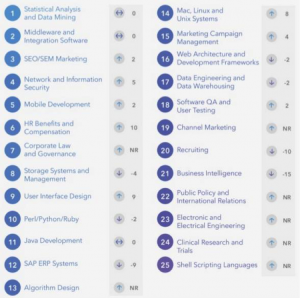The truth is, whenever you go for a job these days, your prospective employer is going to look you up on LinkedIn. There are exceptions to this, of course, but in most cases where someone is looking to make an investment in you and bring you in as a representative of their brand, they’re going to want to find out all they can, and your LinkedIn profile will likely be the first place they look.
As such, it’s crucially important that your profile represents you as best it can, that it highlights your skills and abilities and looks professional, showing that you’re someone worth investing in. But everyone knows this – LinkedIn now has more than 400 million members worldwide, and they’re all trying to stand out, to be found, to showcase their unique abilities.
So how can you make your LinkedIn profile stand out from the pack? Here are a few ideas to help take you to ‘All-Star’ level
(Also, just a note, there’s no level above All-Star, they just leave that tiny sliver at the top of the circle to annoy you. True story.)
1. Fill out your LinkedIn profile
Okay, this is not exactly a mind-blowing insight, but LinkedIn’s very keen on you completing your profile. In fact, completing your profile is pretty much the only requirement of achieving ‘All-Star’ status – the actual, technical requirements to achieve that distinction are:
- A profile photo
- A listing of two or more positions you’ve held, along with descriptions of your roles
- Five or more selected skills
- A summary about yourself
- Completed details relating to your industry and postcode
- A listed school you’ve attended
- At least 50 1st degree connections
That’s it.
It’s actually a bit of a letdown, ‘All-Star’ implies you’ve achieved some level of platform competence, that you’re amongst a select group, but it’s actually pretty easy to get. There used to be a requirement related to recommendations – you needed three recommendations to make the All-Star cut, but they’ve since removed it.
So why does it even matter? According to LinkedIn, “users with complete profiles are 40x more likely to receive opportunities through LinkedIn”.
You’re also more likely to show up in search results if your profile is complete. It used to be that only ‘All Star' Profiles could be shared via Twitter and Facebook, but that functionality has since been removed.
Basically, LinkedIn wants you to complete your profile so they have more data, so they encourage you to do so and will give you a level of preferential treatment, in the form of increased visibility on the platform, for filling it out in full.
2. Use the right keywords
But of course, showing up in searches and increasing your visibility means nothing if the right people aren’t finding you – the right people, being those who are searching for people of your very particular set of skills. So how do you work out the right keywords to use in your profile?
The first point of call is to look at what others in your industry are using – look up people with similar skills and experience and see which ones show up highest in your LinkedIn search and take note of the keywords they’re using. Make sure you use the location filter on the left of screen to hone your results.
LinkedIn’s also conducted internal research on the most sought after skills on the platform, based on recruiting activity – if you have any of these skills, you should definitely list them, using the keywords noted, as they’re evidently in high demand (the below listing is for Australia but the results are broken down by nation here).
LinkedIn also has a listing of the 30 most in demand employers, each of which includes a listing of the top skills they’re commonly looking for. 
If you have an idea of who you’d ideally like to work for, look them up and see what skills they have listed – you can also do this via LinkedIn University Finder, through which you can find the top employers for each skill on the platform. 
Based on this, you can go to the LinkedIn Pages of the top listed employers in each section and look at what titles their employees have listed.
Again, that’s somewhat less exact, but if you can identify the employer you really want to work with, this can be an effective way to get on their radar, as you’re researching the terminology they actually use in their job titles – and likely, what they’ll use when they go looking to new hires.
You can also use Google searches or Google Trends to locate similar matches, but I’d recommend using LinkedIn itself as much as possible, as that’s the place you’re looking to be prominent.
3. Add in links to visual content
Did you know that you can add in links to pretty much every section of your LinkedIn profile? Here’s how a section of mine looks: 
This gives you a chance to showcase your work, obviously, but it also makes your profile stand out, as most people don’t bother to add in links or publish content on the platform. Ideally, this means that when people do visit your profile, they’ll have more reason to stick around and check things out, and it showcases your personal interest in the industry and what you’re doing to actively participate.
Of course, not everyone has links to add in – in that case, I’d recommend getting some. Find what it is you’re passionate about and what you really want to do and get involved by writing a blog post or joining projects which you can link to.
Another option is to make a short introduction video and add that to your profile – video content’s huge on the web right now, and having a personal presence on your profile, even via video, can make you more relatable, more human, as opposed to just another number on the list.
4. Publish long-form content on LinkedIn Publisher
At the start of 2014, LinkedIn opened up its publishing platform to all users. Previously, publishing on LinkedIn was restricted to only a few hundred chosen influencers, but LinkedIn saw the opportunity to give people more ways to showcase their expertise across the professional network and made it possible for all users to publish long-form blog content on the site.
The benefit of LinkedIn publishing is that the posts you write are connected to your profile (the top three in the screenshot from my profile above are LinkedIn Publisher posts), again adding something above and beyond the norm. Your posts, when published, are also shared amongst your LinkedIn connections, and can be further shared through engagement – people liking, commenting, sharing. And if you’re really lucky, you might even get picked up by LinkedIn Pulse, which is curated by LinkedIn’s editorial team. If that happens, your exposure can go through the roof – for example, these are some of my results on normal posts versus a post which of mine which was picked up by Pulse.
‘Significant’ barely captures it. So how do you get the attention of LinkedIn’s editorial team? Honestly, it’s not easy – more than a million LinkedIn members have published content on the platform since the option was made available, with new posts uploaded at a rate of more than 18.5k per day. Standing out from the crowd is obviously a tough ask, but there are a few things you can do to up your chances of being seen.
First, Daniel Roth, the Executive Editor at LinkedIn, recommends that users tweet the editorial team if they have a post they believe is worthy of their attention.
“If you think you have a post that should be featured by Pulse, send a tip to us over at Twitter by adding “tip @linkedinpulse” in your tweet (Here’s a good example). Note: Tipping doesn't mean an automatic channel tag, but it will flag your post for review.”
I would, however, exercise some restraint on this – the editorial team get a heap of notifications like this, more than they’re able to check, and if you’re spamming them or hitting them with notifications every time you publish, they’ll likely come to know your name and stop check out your alerts if you’re wasting their time.
Second, you can publish content based on the theme of the month – each year, LinkedIn publishes an editorial calendar of the topics they’ll be focussing on each month. Here’s the 2016 version.  Writing on these subjects will help you get noticed by the editorial team, as these are the focus areas they’re keen to highlight each month, and are looking for content on. Neither this, nor alerting the team via tweet will guarantee any results, but they may help to get a LinkedIn editor looking your way.
Writing on these subjects will help you get noticed by the editorial team, as these are the focus areas they’re keen to highlight each month, and are looking for content on. Neither this, nor alerting the team via tweet will guarantee any results, but they may help to get a LinkedIn editor looking your way.
Also, please note that hashtags don’t work on LinkedIn. Yes, there are hashtags noted in the subjects listed here, and it’s worth including the relevant tag in your LinkedIn publisher post/s on the subject, but hashtags, in general, are not supported by LinkedIn and should not be used on the platform. Unless you’re trying to highlight that you, in fact, have no idea how hashtags work.
5. Showcase your recommendations
This is a tip from LinkedIn expert John Nemo – John’s suggestion to make your LinkedIn profile stand out is to maximise the value of your LinkedIn recommendations.
As per Nemo’s post:
“While it’s great to have people praising you and your product or service via a LinkedIn recommendation, there's just one problem – almost nobody sees them.”
John recommends that users take quotes from their recommendations and put them into the summary section for more exposure – John’s actually done this in the above example also, including a quote from John Dumas in his summary. In doing so, you’re utilizing the power of personal recommendations about your work and bringing the value of those professional credits front and centre. And John definitely makes a valid point, it’s a lot more effective than reading the same mission statement type bio – and remember, recruiters trying to fill a position are looking through hundreds of LinkedIn profiles, all of them much the same. Anything you can do to be different and stand out will be of benefit.
As noted, LinkedIn has become a massive network with hundreds of millions of members all vying for attention. These little upgrades and changes may seem minor, but in the wider scheme of things, every little bit counts and can help elevate your profile above the rest.
Latest.

5 simple (but powerful) ways to shine in your design interview.
Job Seeker, Design

How to demonstrate the value of your design team in 2025
Thought Leadership, Design, Industry Trends, Leadership

Ace your interview: Words to watch out for.
Job Seeker










